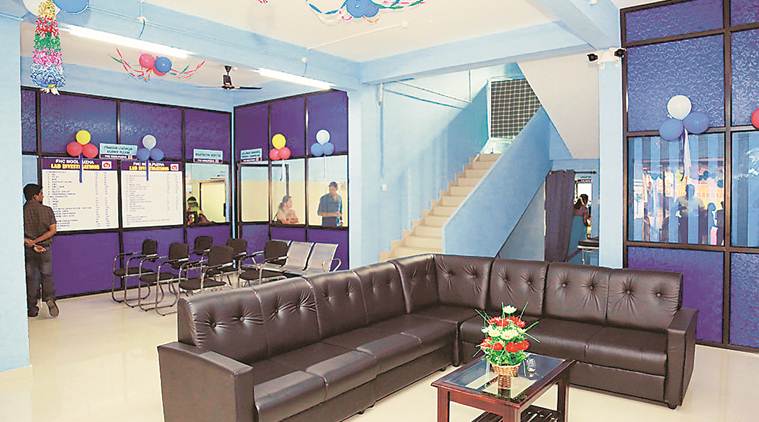 A PHC in Noolpuzha, Wayanad. By the 1970s, Kerala had progressed towards the Centre’s proclaimed objective of creating PHCs for every 1,00,000 population.
A PHC in Noolpuzha, Wayanad. By the 1970s, Kerala had progressed towards the Centre’s proclaimed objective of creating PHCs for every 1,00,000 population.
Kerala was formed by amalgamating the Malayalam-speaking regions of the former princely states of Travancore, Kochi and the Malabar district of the Madras presidency, which later became the Madras state. Both Travancore and Kochi had strong public health traditions. Travancore popularised vaccination in the 19th Century by royal edict. The Maharaja of Travancore is known to have publicly accepted vaccination for his family members and advised his people to follow his example so that their fears may be allayed. They also had strong departments of modern medicine, with general hospitals in Trivandrum and Ernakulam, and Women and Children’s Hospital in Trivandrum.
Travancore appointed Dr Mary Punnen Lukose as the Durbar Physician — one of the highest posts under princely rule. A woman raised to such a position of eminence was a first for India. Dr Lukose, a Syrian Christian, had studied medicine in England, when few women had the opportunity to do so even in western countries.
In the 1930s, the Rockefeller Foundation, an American charitable organisation, sent a team to study the health conditions in Travancore, and they conducted extensive surveys in the state. They found that worm infestation was rampant among both adults and children. Dr Krishnan Thampi was then deputed to Johns Hopkins University to study public health. He returned with a doctorate degree and started a Primary Health Centre in Neyyattinkara, near Trivandrum. This was much before the official launching of PHCs as peripheral health units.
Early development was not restricted to health: if anything, it was more evident in education. Travancore, Kochi, and to a certain extent Malabar, were ahead of other states in India in providing access to primary and secondary education to people. This was the result of early investment in the school system by the Maharajas, as well as the initiatives of missionaries who were active in the state, and other community organisations, cutting across caste and class barriers. The education of girls was also specifically emphasised.
Spending on health
Crude death rate and infant mortality rate in these regions started to trend below the all-India figures as early as 1911. The proportion of births in hospitals also went up. By 1957, Kerala already had better statistics in education, health, birth and death. Over the years, successive state governments have spent a large proportion of their expenditure on these ‘service’ sectors. This as a proportion of public expenditure is among the largest among Indian states.
By the 1970s, the state had progressed towards the Indian government’s proclaimed objective of creating PHCs for every 1,00,000 population. The common people, especially women and children, used these health centres. Childbirths in health care institutions became more common rather than at home. In this, the improvement in education of women helped, as the taboos against women coming out of their homes fast disappeared. In a sense, the state as a whole moved in a trajectory that in other parts of India was perhaps confined to the urban areas.
Fiscal problems & rise of private sector
By the 1980s and ’90s though, the state had run into fiscal difficulties. The growth of revenue expenditure, largely going to salaries of staff, squeezed the spending on infrastructure and consumables, in turn affecting the quality of care. Since the public continued to demand hospital care, the situation provided ample scope for the growth of a thriving private sector in health. By the latter half of the 1990s, the facilities in private institutions had outgrown those in government institutions; a larger proportion of the public also preferred private care, as shown in surveys.
World Bank & other interventions
Around this time, the World Bank and other lending institutions increasingly provided loans for health system development, and Kerala was one of the Indian states to make use of them. At the same time, the World Bank, in line with its philosophy of encouraging private initiative, tried to restructure the government health system, significantly pressing for the introduction of user fees. In Kerala, this was resisted by a strong coalition of civil society.
One important piece of legislation at the time was instrumental in changing the face of healthcare again: the decentralisation of power to the panchayats and other local bodies. This brought health institutions under the direct administration of local bodies, and also provided them more funds. Many local bodies utilised this opportunity to improve the facilities in hospitals. This was the beginning of revival of the public sector in health in Kerala.
Re-emergence of the public sector
Recent years have seen many initiatives in the government health sector, and 10-20 per cent of people have moved back to the public sector. More sophisticated care is available at taluka and district hospitals as well as government medical colleges. Successive governments have provided improved funding at different tiers of government institutions. This has been facilitated in recent years by committed political leadership in the health sector, supported by competent bureaucracy, helping the state weather repeated challenges posed in recent years by two devastating floods as well as threat of the Nipah virus. And now, Kerala continues to deal competently with the Covid-19 pandemic as well.
This article appeared in the print edition of May 10, 2020, under the title ‘Behind Kerala corona success, a long legacy’. The author is a public health expert and an emeritus professor at the Sree Chitra Tirunal Institute for Medical Sciences and Technology